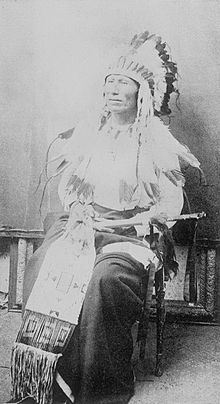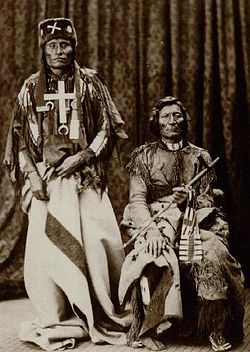- Morning Star (chief)
-
Morning Star (Cheyenne: Vóóhéhéve,[1] also known by his Lakota Sioux name Tamílapéšni, Dull Knife[2][3]) (born c. 1810, died 1883), was a great chief to the Northern Cheyenne people during the 19th century. He was noted for his active resistance to Western expansion and the Federal government. It is due to the courage and determination held by Morning Star and other Cheyenne leaders that the Northern Cheyenne still possess a homeland in their traditional country (present-day Montana).
Although he was known as "Dull Knife" (or Motšêške Ôhnêxahpo in Cheyenne, a translation of his Lakota name) to local settlers, U.S. military leaders, and other American Indians, his Cheyenne name is Morning Star. A Cheyenne warrior in every sense of the word, Morning Star was described by many writers of the century as "an admirable outlaw" compared to others like Rob Roy and William Wallace.
In 1868, Morning Star represented his tribe at the signing of the Treaty of Fort Laramie. Following "Custer's Last Stand" at the Battle of Little Bighorn in 1876, Morning Star allied with the Sioux and other tribes against the United States. However, after a disastrous raid (the Dull Knife Fight) by American soldiers in which 153 lodges were destroyed and 500 war ponies captured, most of the Cheyenne were eventually forced to surrender. They were transported to the Indian Territory in Oklahoma.
Eventually, unable to hunt, the tribe suffered from starvation and disease until September 1878 when Morning Star began to lead the tribe north back toward their ancient homelands. Fighting through, the Cheyenne were able to outmaneuver Federal troops in the Nebraska Sand Hills until they were captured near Fort Robinson in Nebraska. The tribe was said to have taken apart their guns, hidden under blankets or worn as necklaces and bracelets by children. On January 8, 1879, the tribe again tried to escape north when most of the Cheyenne, mostly women and children, were killed by Federal troops. However a few of the tribe managed to escape, including Dull Knife.
Morning Star died in 1883 and was buried on a high hill at Lame Deer, Montana, near the Rosebud River (now known as Stillwater River), overlooking the land where he had led his people.
Chief Dull Knife College in Lame Deer, Montana was named in his honor.
His photograph, as Dull Knife, appears in Dee Brown's 1971 bestseller Bury My Heart at Wounded Knee.
References
- ^ "Cheyenne Dictionary" (September 5, 2007 version). Chief Dull Knife College. http://cheyenne.110mb.com/. Retrieved September 19, 2007.
- ^ Recorded as Tah-me-la-pash-me; from ta (his) + míla (big knife) + péšni (dull)
- ^ Buechel, Eugene; Paul Manhart (2002) [1970]. Lakota Dictionary: Lakota-English/English-Lakota (New Comprehensive Edition ed.). Lincoln and London: University of Nebraska Press. ISBN 0-8032-1305-0. OCLC 49312425.
- Grant, Bruce, The Concise Encyclopedia of the American Indian, 3rd ed., Wings Books: New York, 2000.
External links
- Encyclopedia of Oklahoma History and Culture - Dull Knife
- Dull Knife, Native Northern Cheyenne Chief at Find a Grave
Further reading
- Donald J. Berthrong, The Cheyenne and Arapaho Ordeal (Norman: University of Oklahoma Press, 1976).
- Stan Hoig, Perilous Pursuit (Boulder: University Press of Colorado. 2002).
- John Stands in Timber, Cheyenne Memories (New Haven: Yale University Press, 1967).
- Brown, Dee (2003). Bury My Heart at Wounded Knee: An Indian History of the American West. Macmillan. ISBN 0805066691. http://books.google.com/books?id=pWpZMYVG4MoC.
- Grinnell, George (2004). The Fighting Cheyennes. Digital Scanning Inc. ISBN 1582183902. http://books.google.com/books?id=MC3ZJt9IjFsC.
- Sandoz, Mari (2005). [l = http://books.google.com/books?id=xre15x_bCzUC Cheyenne autumn]. U of Nebraska Press. ISBN 0803293410. l = http://books.google.com/books?id=xre15x_bCzUC.
- Eastman, Charles (2004). Indian Heroes and Great Chieftains. 1st World Publishing. ISBN 1595400591. http://books.google.com/books?id=fMTwGXjBuoIC.
- Monnett, John (2004). Tell Them We Are Going Home: The Odyssey of the Northern Cheyennes. University of Oklahoma Press. ISBN 0806136456. http://books.google.com/books?id=KE-fUdZLfy8C.
- Dockstader, Frederick (1977). Great North American Indians: profiles in life and leadership. Van Nostrand Reinhold. ISBN 0442021488. http://books.google.com/books?id=VFgYAAAAIAAJ.
- Starita, Joe (2009). "I Am a Man": Chief Standing Bear's Journey for Justice. Macmillan. ISBN 0312533047. http://books.google.com/books?id=HNKOVCaXR4MC.
- III, Joseph (2005). The Journey of Crazy Horse: A Lakota History. Penguin Group. ISBN 0143036211. http://books.google.com/books?id=QieOVrOhlW8C.
- Blackmar, Frank (1912). Kansas: A Cyclopedia of State History, Embracing Events, Institutions, Industries,Counties, Cities, Towns, Prominent Persons, Etc, Volume 2. Standard Pub. Co.. http://books.google.com/books?id=o8X5krq3fP8C.
Categories:- Cheyenne people
- Native American leaders
- People of the Great Sioux War of 1876–77
- 1883 deaths
- People from Montana
Wikimedia Foundation. 2010.


